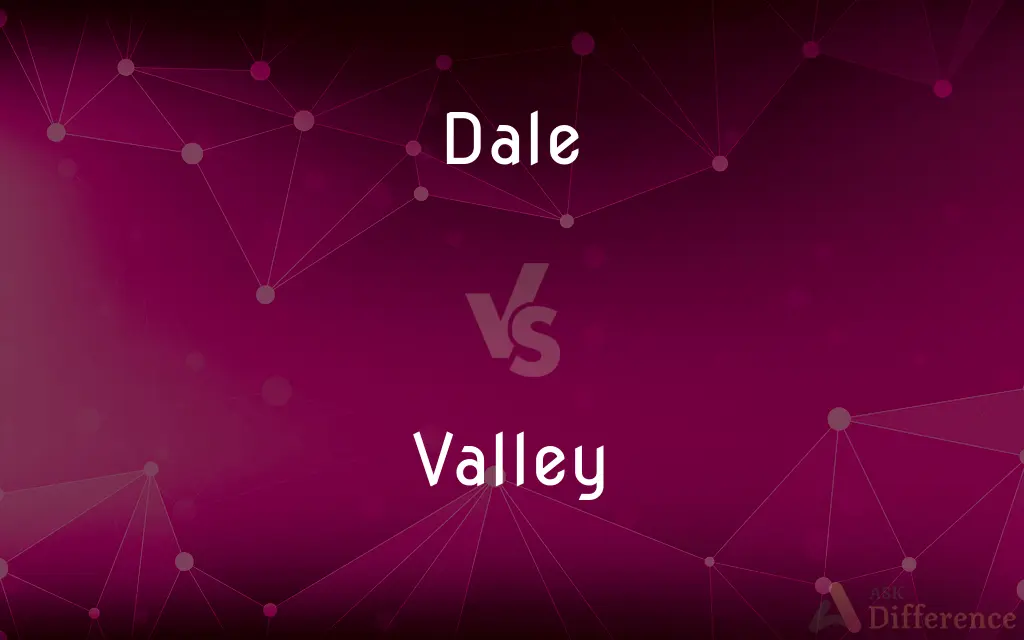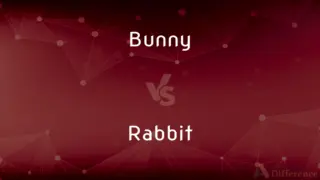Dale vs. Valley — What's the Difference?
By Tayyaba Rehman — Updated on October 5, 2023
A dale is a broad, open valley, often in an upland area, while a valley is a low area between hills or mountains where a river often runs. E.g., "We hiked through the picturesque dale." vs. "The valley was lush and fertile."

Difference Between Dale and Valley
Table of Contents
ADVERTISEMENT
Key Differences
Dale and valley, while both pertaining to geographical formations, present distinct connotations and usages, each fostering its unique imagery and associations. A dale often alludes to a wide, often grassy and open area nestled amongst hills, exuding a sense of serene landscapes and open spaces. Valleys, on the other hand, encapsulate a broader definition, highlighting a low area between hills or mountains, often featuring a river.
In literature and daily communication, a dale oftentimes conveys pastoral, tranquil imagery and is sometimes employed in poetic or idyllic contexts, promoting a sense of peaceful and rural escape. A valley, maintaining versatility in usage, may represent various landscapes, from fertile, vibrant areas to dry, desert-like passages, thereby embodying a multifaceted geographical concept.
The geographical spread and use of the word "dale" appear predominantly in certain regions, such as the United Kingdom, where it portrays specific landscape features reminiscent of local terrains. Conversely, the term "valley" enjoys a more universal application, representing varied terrains across diverse geographical settings, thereby being a more common term in global usage.
Through a linguistic lens, "dale" may be perceived as slightly archaic and specific, often enveloped in a bucolic, literary aura. "Valley," showcasing its linguistic adaptability, permeates a wider array of contexts and dialogues, functioning as a staple term to depict low-lying land between elevations, without being bounded by specific characteristics or localities.
"Dale" and "valley," while sharing a foundational similarity as geographical terms, subsequently diverge in their applications, connotations, and prevalence, enriching language and descriptions with their distinct textures, regional flavors, and adaptabilities to varied landscapes and interpretations.
ADVERTISEMENT
Comparison Chart
Basic Meaning
Open, often upland valley
Low area between hills/mountains
Example Usage
They picnicked in the sunny dale.
The river cut through the valley.
Regional Usage
More common in the UK
Widely used globally
Connotations
Often bucolic and serene
Can represent varied landscapes
Prevalence in Language
Less common, somewhat archaic
Common, versatile usage
Compare with Definitions
Dale
A broad valley in the countryside.
We hiked through the peaceful dale, enjoying the scenery.
Valley
A low area between hills or mountains, often with a river running through it.
The valley was bathed in the warm light of the setting sun.
Dale
A depression or hollow, often alongside a river.
The sheep grazed in the dale, sheltered from the winds.
Valley
A depressed or sunken area in relation to surrounding areas.
We could see the entire city from the top, including the valley below.
Dale
A low-lying area between hills or mountains.
The village was nestled comfortably in the dale.
Valley
A geographical region characterized by its low position.
The valley has its own unique climate due to its sheltered position.
Dale
An open river valley in a hilly area.
The river flowed gently through the dale, reflecting the surrounding hills.
Valley
The internal angle formed by the meeting of two sloping sides.
Water collected in the valley of the roof, causing a leak.
Dale
A stretch of open land in a valley.
The dale was filled with wildflowers in the spring.
Valley
An elongated depression between uplands, hills, or mountains.
The valley stretched for miles, surrounded by majestic peaks.
Dale
A valley, especially in northern England.
Valley
A valley is an elongated low area often running between hills or mountains, which will typically contain a river or stream running from one end to the other. Most valleys are formed by erosion of the land surface by rivers or streams over a very long period of time.
Dale
A valley
Galloped over hill and dale.
Valley
A low area of land between hills or mountains, typically with a river or stream flowing through it
The valley floor
The Thames Valley
Dale
A valley, often in an otherwise hilly area.
Valley
An internal angle formed by the intersecting planes of a roof, or by the slope of a roof and a wall.
Dale
The sunken or grooved portion of the surface of a vinyl record.
Valley
An elongated lowland between ranges of mountains, hills, or other uplands, often having a river or stream running along the bottom.
Dale
(archaic) A trough or spout to carry off water, as from a pump.
Valley
An extensive area of land drained or irrigated by a river system.
Dale
A low place between hills; a vale or valley.
Where mountaines rise, umbrageous dales descend.
Valley
A depression or hollow resembling or suggesting a valley, as the point at which the two slopes of a roof meet.
Dale
A trough or spout to carry off water, as from a pump.
Valley
An elongated depression cast between hills or mountains, often garnished with a river flowing through it.
Dale
An open river valley (in a hilly area)
Valley
An area which drains itself into a river.
Valley
Any structure resembling one, e.g. the interior angle formed by the intersection of two sloping roof planes.
Valley
To form the shape of a valley.
Valley
The space inclosed between ranges of hills or mountains; the strip of land at the bottom of the depressions intersecting a country, including usually the bed of a stream, with frequently broad alluvial plains on one or both sides of the stream. Also used figuratively.
The valley of the shadow of death.
Sweet interchangeOf hill and valley, rivers, woods, and plains.
Valley
The place of meeting of two slopes of a roof, which have their plates running in different directions, and form on the plan a reëntrant angle.
Valley
A long depression in the surface of the land that usually contains a river
Common Curiosities
Are "dale" and "valley" synonyms?
While similar, "dale" often refers to an open, upland valley, whereas "valley" is a more general term.
Can a "valley" be desert-like?
Yes, valleys can exist in varied environments, including arid regions.
Does a "valley" always contain a river?
No, while common, valleys do not necessarily contain rivers.
Is "dale" commonly used in the US?
"Dale" is less common in the US, with "valley" being more prevalent.
Is "dale" specific to certain countries?
"Dale" is more commonly used in the UK and may be found in specific place names.
Does "dale" infer a certain size?
No fixed size, but "dale" often conveys a sense of open, expansive valleys.
Can "valley" refer to metaphorical lows?
Yes, "valley" can metaphorically represent low points, e.g., "valley of despair."
Can a "valley" be found in urban settings?
Yes, valleys can be found in or near urban areas.
Can a "valley" have a flat floor?
Yes, valleys can have flat floors, often leading to agricultural use.
Is "dale" a modern English term?
"Dale" may be considered slightly archaic or regional in modern usage.
Is "dale" often used in poetry?
Yes, "dale" has been used poetically to convey serene landscapes.
Can a "valley" be formed by volcanic activity?
Yes, valleys can form through various geological processes, including volcanic activity.
Does a "valley" have notable vegetation?
Vegetation in a valley varies widely based on geography, climate, and local ecosystems.
Is "dale" used in non-geographical contexts?
Rarely, "dale" is primarily a geographical term.
Is "dale" used in official geographical names?
Yes, "dale" is used in place names, especially in regions like Yorkshire.
Share Your Discovery

Previous Comparison
Bunny vs. Rabbit
Next Comparison
Cult vs. OccultAuthor Spotlight
Written by
Tayyaba RehmanTayyaba Rehman is a distinguished writer, currently serving as a primary contributor to askdifference.com. As a researcher in semantics and etymology, Tayyaba's passion for the complexity of languages and their distinctions has found a perfect home on the platform. Tayyaba delves into the intricacies of language, distinguishing between commonly confused words and phrases, thereby providing clarity for readers worldwide.
















































